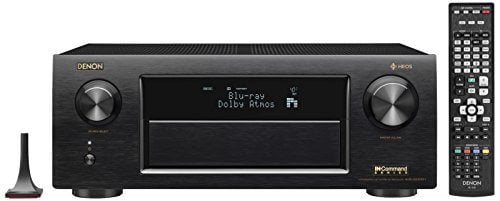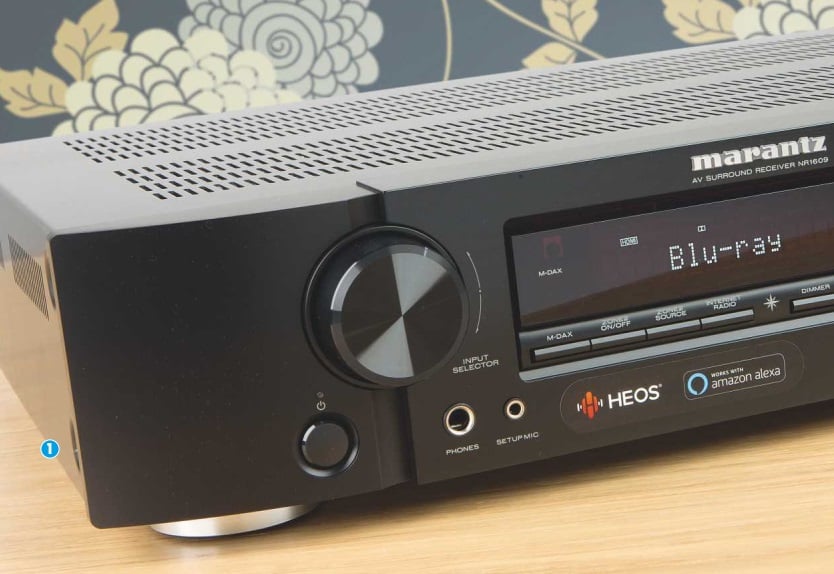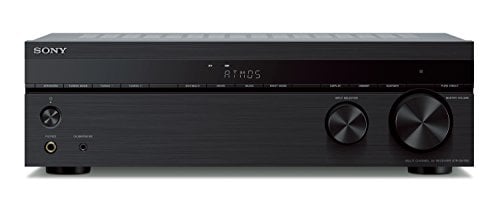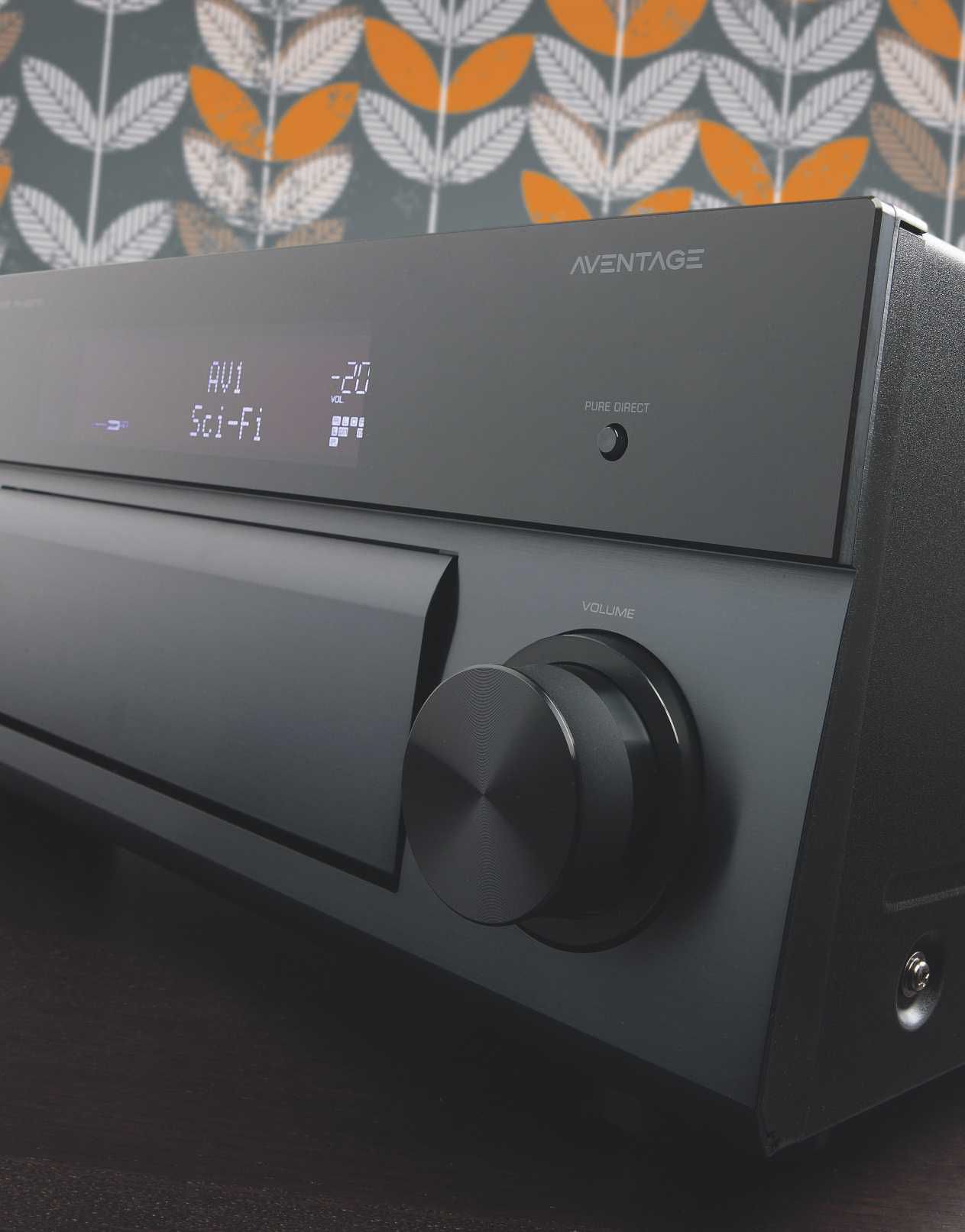DENON AVR-X6400H Review: Next-gen sound united

Denon has invited all 3D audio formats to an AV party – plus Richard Stevenson. Read our DENON AVR-X6400H Review.
Evolution, not revolution, is a good way of describing Denon’s AVR-X6400H. This AV receiver takes last year’s very fine AVR-X6300H, adds a few features, sprinkles in some new components and ices the cake with Auro3D format support straight out of the box.
I like it already. The engineering and cosmetic design are untouched.
Table of Contents
On the outside it’s a black box. with two big knobs, blue-tinted display and a flap concealing buttons and sockets. That’ll be an AVR then. Inside is Denon’s Monolithic amplifier layout, custom transistors and a power output claimed to be 205W for all of its eleven channels. Into a more realistic 8 ohm load with real movie material the suggestion is nearer to 140W per channel. Put another way. this isn’t short on power for a one-box AV offering.
This new kid gets Denon’s flagship AL32 multichannel processing and 192kHz/32-bit DACs. There is 5.1 bi-amping mode. Dolby Vision HDR compatibility, and eARC, Dolby Atmos 7.1.4, DTS:X and Auro3D are all catered for with an incredibly flexible speaker positioning setup.
In fact from 7.1.4 to full triple-layer Aura, there is quite a bewildering array of speaker combinations in between. Okay, while you could count all the mainstream Auro3D BDs on one hand and still have enough fingers left over to do some impressive shadow-puppetry, you also get AuroMatic upmixing. This takes channel-based and object-based formats and remaps them to an Aura speaker config.
The AVR-X6400H features Bass Sync, first seen on Denon’s X7200WA. This aims to compensate for LFE delays in some BDs, up to 16ms. While you’re unlikely to be able to notice a bass delay of a few milliseconds, it could cause LF phase issues between sub and main channels.
It’s purely a manual adjustment, which beggars the question of how do you know if the LFE needs syncing?
By way of an answer. Denon’s tech guys sent me over a list of ‘offending’ BDs. with LFE sync issues ranging from 1ms to 10.8ms in the case of Michael Jackson’s This Is It. You would need to know and then manually adjust the LFE delay on each disc you play, and then possibly won’t hear the difference. So. yes. it’s clever, but let’s file that one under ‘nice to have, never going to use it.’
Around the back of the receiver’s full-width, full-height chassis are Bluetooth and Wi-Fi 2.4/5GHz aerials, as well as an Ethernet port for networked features. These naturally provide full integration with Denon’s HEOS multiroom hardware. The X6400H also proffers AirPlay. internet radio and a raft of built-in streaming services including Deezer. Spotify and Tidal for a bit of hi-res audio goodness.
HDMI connectivity is outstanding. With eight HDMI inputs and three outs you are unlikely to be left wanting.
All are HDMI 2.0/HDCP 2.2 complaint and offer 4K 60Hz HDR passthrough. There’s also scaling to 4K for non-UHD material, and the video output can be ISF calibrated.
Neatly lined up along the bottom of the rear panels are 11 pairs of output terminals with gold-plated binding posts and 4mm banana sockets.
Control is by a chunky but effective remote handset, sadly not backlit. You can also use the AVR Remote app. or a web interface. The remote is the way to go for setup, as the Audyssey MultEQ XT32 suite, setup wizard and GUI are Denon’s most slick and comprehensive to date.
AV INFO
11-channel AV receiver with Atmos, DTS:X and Auro3D
Below Denon’s top X7200WA, but has a more up-to-date specification
Anthem MRX 1120: Pioneer SC-LX901
- All front inputs hide behind the Denon’s drop-down flap
- The remote is relatively uncluttered, but lacks a backlight
Selecting your current speaker configuration is easy. Choosing a new speaker configuration from scratch, less so. You see. Dolby/DTS and Auro3D have rather different ‘best’ speaker layouts for your 11 channels. Dolby Atmos is 7.1.4. comprising traditional 7.1 plus four speakers in the ceiling. Auro3D here uses a traditional 5.1 setup, plus four speakers placed above the surround and main pairs, angled down to the listener. A further single ceiling speaker above the listener acts as a top layer, otherwise known as Auro’s Voice of God channel. You need one or other speaker setup, as the twain does not meet easily. It is an either/or thing, really.
Now those with the correct number of countable fingers will note that last configuration is 10-channel, or ‘Home Theatre/Small Room’ setup as Aura calls it. Denon has not integrated Aura’s Centre-Height speaker, despite having a spare amp to drive it. That would have given you the full 11-channel ‘Cinema/Large Room’ setup.
The Denon’s sound is quick-footed and articulate – bass thunders but never drowns or overbears the details.
So. what do you do? Well, as Atmos, DTS:X and Aura are all object-based processing, arguably it’s not that important where your speakers are. The AVR’s setup and processing should make the best of whatever speaker configuration you have. The issue is you need to tell the amp you have an Aura speaker setup to use Auro3D or AuroMatic upscaling. Tell it you are all Dolby and it only gives you Auro2D.
Given the plethora of native Dolby/DTS material, we would suggest running 7.1.4 and then just telling the AVR that the layout is Auro and let Aura jiggle its processing to suit that speaker arrangement. That’s what I did… although I probably should have checked the Denon’s lack of HC channel ability before installing another speaker just for this review. D’oh!
Sounds familiar
Sonically, there is not much difference between the AVR-X6400H and last year’s X6300H. That is no bad thing at all. The sound is quick-footed, detailed and articulate. Unlike Denon AVRs of old that crafted action movies with Uzi gusto and steroidal bass, this latest generation is more refined, more spacious and probably more faithful to the director’s intent
Despite Lucy being one of Scarlet Johansson’s most Marmite cinematic endeavors, it’s a visual and aural delight. Even though the regular BD is saddled with a 5.1 mix (when it was Atmos in the cinema… go figure), there is no shortage of sonic fiesta. When a drug-fueled Lucy bounces around her prison cell the sound is super-dramatic and filled with well-placed effects. Bass thunders along from my twin-sub setup but never drowns or overbears the details.
Switching straight to Morgan Freeman’s monologues at chapter breaks is a jolt. The large lecture theater really highlights the Denon’s skill at crafting ambience. You are moved seamlessly from drama in a cramped cell to open, spacious and relaxed academia. Morgan’s voice has a pleasing bassy tone – lesser amps often turn that into an over-rich boom, crafting a Morganzilla of a character. Not so with the AVR-X6400H. Freeman’s voice remains lifelike and every bit the university lecturer.
With native Atmos sound the Denon simply goes up a notch in its spacious presentation and precision detail. That accuracy had already made me reach for Gravity (Blu-ray) and the AVR-X6400H renders its stunning mix with consummate ease. It doesn’t simply pull you into the narrative but pulls you right into the atmosphere.
Or lack thereof. The sheer sonic sense of open, vacuous space, and latterly being under water, is thrilling.
For something a little less cerebral, the Ghostbusters remake is a disc that will only ever grace my player again for testing purposes. It’s a howling movie [no it isn’t – Ed] but the sound is right up there with some of the funkiest Atmos soundtracks available. Its up-beat songs really show off the Denon’s dynamic panache, while dialogue punches through with real intelligibility. That’s not a good thing with Ghostbusters. but better movies will certainly benefit.
Like Deadpool. The AVR-X6400H steps to the plate with the big. all-action opening sequence, complete with immaculate slow-mo car-crashes and our hero’s to-camera quips. The gunshots, blades, crashes, ricochet bullets and general mayhem are exquisite, backed by LFE effects with a very tight and forceful, if not seismic, punch.
If you have set up your speakers as Auro3D. you will still need to set the AVR to 3D in the movie sound format menu – there is no flagging. With an Auro test disc featuring clips from Inferno, the sound was every bit as immersive as Dolby Atmos. I would go so far to say there was even more space in the size of the soundstage with Auro3D. That might just be down to the mixing, but it was mightily impressive. With music test tracks, I would add that Auro sounded even better than Dolby’s or DTS’s equivalents.
Upscaling a Dolby or DTS mix in Auro3D was. well, interesting. I could only A/B demo using my usual speaker setup and some serious fiddling with settings, convincing the AVR my Dolby setup was actually Auro configured. There was very little difference in formats. Even in a quick blind test it was hard to tell, but I did end up voting for native Dolby Atmos. Was that just because my speakers were in the proper Atmos position?
I also could not get full 7.4 layering in Auro3D or AuroMatic. as the rear back info defaults to the surround speakers. I spent some time with Denon’s tech department on this and it is a restriction within Auro when mapping onto a Dolby speaker matrix. Like I said, either/or then.
Aside from this, you won’t be disappointed if you set out to create an Auro system with Auro speaker positioning, or a Dolby/DTS system with Dolby speaker positioning. Both are outstanding.
At which point I reckon my Marantz processor and stack of power amps are looking nervous. The Denon is very good, a fraction of the cost and delivers Auro3D without me paying for an upgrade to the Marantz. Yet switching back to my system. I was aware of more presence and sheer scale, particularly when the volume gets to ASBO levels. It’s not that the Denon is short of power, but the more you push it the more its detailed and articulate balance feels like it could do with just a little more grunt and body.
Peerless at the price
Overall. Denon’s new. more grown-up and sophisticated character shines through on the AVR-X6400H. Its feature set is peerless at the price, the sonic clarity and definition outstanding and. generally, its easy to use. I’m not wholly convinced by the need or implementation of Auro3D but it’s certainly a nice option to have. This is on its own in terms of skills and classy performance
Verdict
Denon’s latest AVR offers unrivaled features and Auro3D out of the box. and delivers immersive, hyper-realistic sound. A cracking receiver.
3.11.2-channel preouts let you partner the Denon’s processing with external amps
SPECIFICATIONS
DOLBY ATMOS: Yes DTS:X: Yes THX: No MULTICHANNEL INPUT: No MULTICHANNEL PREOUT: Yes. 11.2 phono output MULTICHANNEL OUTPUT (CLAIMED): 11 x 205W (into 6 ohms) MULTIROOM: Yes. Zones 2 and 3 AV INPUTS: 5 x composite; 4 x digital audio (2 x optical and 2 x coaxial) HDMI: Yes. 8 x inputs; 3 x outputs COMPONENT VIDEO: Yes. 2 x inputs; 1 x output VIDEO UPSCALING: Yes. To 4K/60 DIMENSIONS: 434(w) x 393(d) xl67(h)mm WEIGHT: 14.5kg
FEATURES
Auro3D out of the box; AuroMatic upmixing; HEOS multiroom integration; Audyssey MultEQ XT32 room EQ and setup; Denon setup wizard; dual-band Wi-Fi; Bluetooth; Ethernet: USB; 192kHz/32-bit DACs; AL32 Processing Multichannel; FLAC. WAV. ALAC and DSD hi-res audio support; AirPlay; Spotify Connect: TuneIn radio: Bass Sync
PARTNER WITH
B&W DB1D: Combine the AVR-X6400H’s detailed sophisticated character with a detailed, articulate subwoofer. B&W’s flagship DB1D isn’t cheap, but its performance, design and setup flexibility are exemplary.





